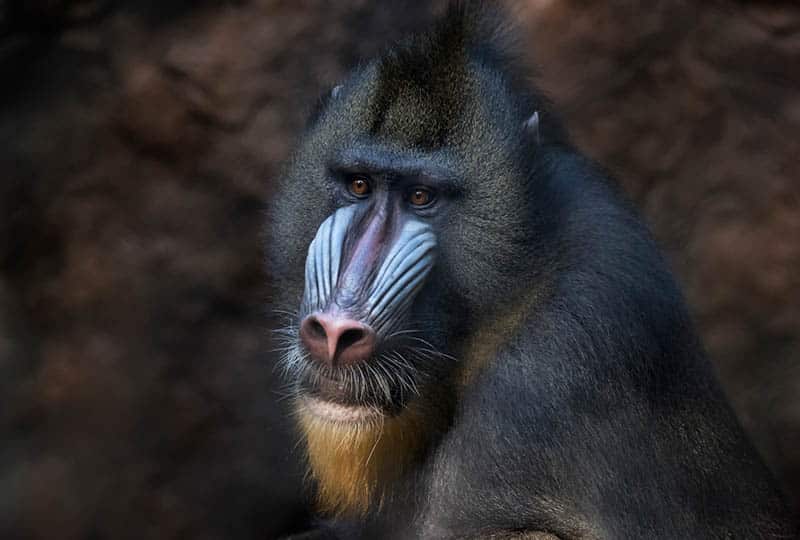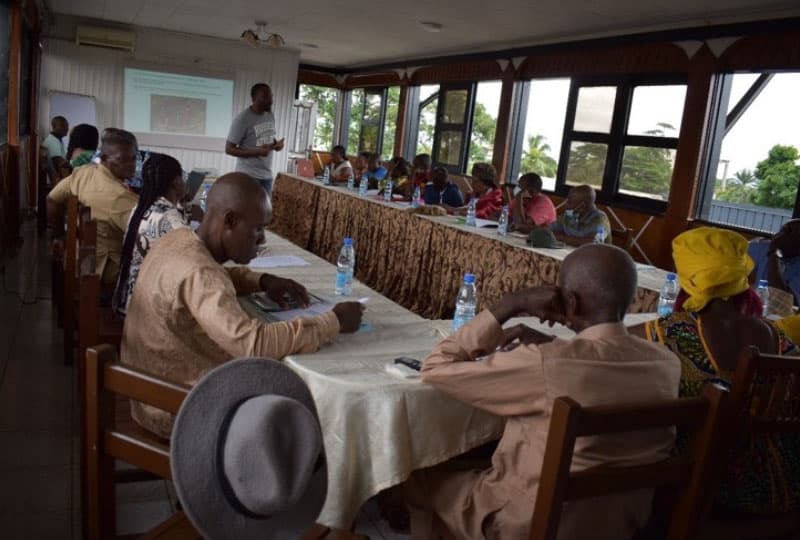The bad news came through at their weekly team meeting: a new decree (N°2019/4562 of 11 November 2019) had been issued, allocating 60,000 ha of Campo Ma’an forest in southwest Cameroon to CAMVERT, an agro-industrial giant producing and marketing palm oil.
The Green Development Advocates (GDA) team sprang into action.
This is the story of how a small but mighty Cameroonian organisation supported its community to take on CAMVERT and win, protecting 20,000 ha of this precious forest and its people.
Campo Ma’an National Park: exceptional biodiversity on the line
In southern Cameroon, a vast equatorial forest meets the Atlantic Ocean. This deep expanse of thick, evergreen canopy is Campo Ma’an National Park, which covers some 264,064 ha. Thought to be one of the few regions that persisted as a tropical rainforest through the Ice Age, it hosts an incredible array of biodiversity, with some of the world’s most charismatic animals, hundreds of species of reptiles and fish, and over 300 species of birds.
Some species are found nowhere else on Earth, and several are on the International Union for Conservation of Nature (IUCN) Red List. The giant pangolin, the African elephant, the lowland gorilla, the chimpanzee, the buffalo, the panther, and the mandrill – a strikingly colourful primate – all fall into the latter category.
Alongside this, Campo Ma’an National Park is also home to a large local population who make their living from this protected area. For the Indigenous Bagyeli community, the forest is their resource.
This extraordinary heritage is threatened by the conversion of 60,000 ha of Campo Ma’an Park to agro-industry, primarily for oil palm plantations.

The mandrill is just one of many species threatened by habitat loss in the forest of Campo Ma’an. © iStock
Working together to fight destructive industry
This area has long been targeted for extractive practices from oil, logging, and plantation industries. In response, groups of local people have rallied together to protect the forest and resist the land grabs that encroach on it. A leading coordinator and voice of this resistance is Green Development Advocates (GDA) – a Cameroonian organisation empowering forest communities and Indigenous Peoples to protect forests from larger-scale destructive developments and support sustainable activities.
Focused on forests in Southwest Cameroon, GDA pushes for the inclusion of local community and Indigenous peoples’ rights in the development process, especially when parts of the forest are allocated to companies for economic projects. They use their legal expertise to carry out evaluations of current laws and practices, build the capacity of local and national civil society organisations, and develop initiatives to alleviate poverty.
Using community forestry to secure land, GDA works alongside communities to support them at every stage, from learning about Community Forestry Concessions to applying for titles and eventually managing the land.

Members of the local Bagyeli community. © Marie Claude Simard
Revealing the true cost of ‘development’
The first priority of the GDA team was to talk to the community to understand their views on the project. The team carried out a number of local surveys, meeting with local people and other stakeholders in the area. On returning to Yaoundé, the team analysed the legal texts in force, and very quickly sounded the alarm on the real threats posed by this project through four major publications.
The first study presented the various breaches of forestry law relating to the downgrading and allocation of the provisional concession. The second study, entitled Analysis of the negative impact of the CAMVERT agro-industrial project on the biodiversity of Campo Ma’an, shows the potential damage of the project to the fauna and flora of the Campo area. With Greenpeace Africa, GDA also produced a report entitled ‘Camvert: a recurring nightmare’, which enables local and Indigenous communities to express their fears about the project. These publications were widely shared on GDA communications platforms and at national and international meetings.

Presenting the results of a study on the potential impacts of the CAMVERT agro-industrial project to local community members in Campo Ma’an, 2020. Image © GDA
Strengthening community leadership to protect people and forests
With no response forthcoming from political decision-makers, GDA organised field visits with members of the media to witness first-hand the reality on the ground – as described in the studies – so they could investigate further. Several journalists followed up with articles alerting the national and international media to the potential consequences of the project on community life, the environment and biodiversity.
Meanwhile, GDA focused on organising advocacy training and capacity-building workshops for community leaders and traditional chiefs to give communities the tools and autonomy they needed to defend their rights and living space themselves. Members of the communities wrote to the President of the Republic of Cameroon to denounce the destruction of their land and the fear they feel due to the upsurge in human-wildlife conflicts.
Women from the 19 communities of Campo also set up the Association des Femmes Riveraines un Seul Coeur (AFRISC-Campo) to make their voices heard at national and international meetings.
David 1: Goliath 0 – a winning mobilisation
This great community mobilisation around Campo Ma’an is about to bear fruit. GDA and community leaders were granted an audience at the Ministry of Forests and Fauna (MINFOF) and the Ministry of the Economy, Planning and Regional Development (MINEPAT) to present and explain their grievances relating to the CAMVERT agro-industrial project.
Following these meetings, the communities and GDA heard the news they had been waiting for: a major victory! The area allocated for oil palm plantations was reduced from 60,000 ha to 39,923 ha. Through its actions, GDA was able to secure over 20,000 ha of their precious and irreplaceable forest.

As well as this river, Campo Ma’an National Park features mountains and plateaus in the north, hills and small valleys in the south, and beaches which are home to marine turtles. © GDA
The work continues
GDA is continuing to support the people of Campo, promoting agroecological practices such as intelligent diversification of field crops and growing and sharing seeds. Other households will receive support to raise chickens. These measures are helping to diversify the diet of the Indigenous and local communities affected, curb their consumption of bushmeat, improve their living conditions, and reduce the pressure on wildlife biodiversity around the Campo Ma’an National Park.
“Before, communities were neither accepted nor listened to, but now their voices count!” Mba Mbia Danielle, Nguena Mawamba Carrele, Project Officers, GDA.
The power of community
In this battle to protect their land, local people are becoming more aware of their rights and that these rights must be respected. GDA helps communities to understand the laws and practices that exist, and builds their capacity to advocate for themselves. By empowering communities with the tools to take charge of their own destinies, GDA supports them to fully secure their land, reduce poverty and protect the forests against projects that threaten their lives and livelihoods.
This is the power of the GDA model – showing that small, local actors working with communities can defeat huge corporations, and holding a beacon of hope for others to do the same.
Conserving forests and biodiversity cannot be achieved without the contribution of local communities and NGOs: supporting communities to protect their land and rights is a core objective of Synchronicity Earth’s Congo Basin Programme.
We are proud to support organisations like GDA who prove that the ‘big guys’ don’t always win!





